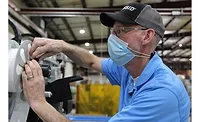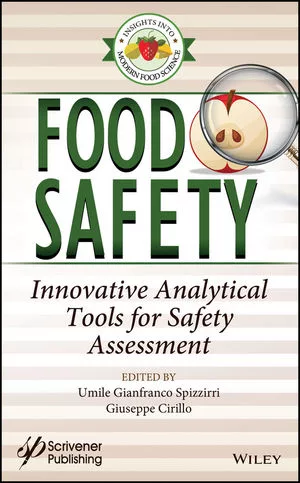Emerging Analytical Techniques for Shelf Life

An interview with Ray Marsili, Dean Foods Technical Center.
Food Safety Magazine: As an overview, would you describe the importance of shelf life stability testing in the food industry and the food chemist’s role in this area?
Ray Marsili: Shelf life stability testing is becoming more important, and this is an area where food chemists can really help their companies. There are a few reasons why shelf life is becoming a bigger issue for food manufacturers. First, food companies are being asked more frequently than ever before to extend the product shelf life of just about every product one can imagine, in addition to the traditional push to get new products to market. Consolidation in the food retailing and manufacturing industries means that foods are being shipped longer distances and this is increasing the need for longer shelf life. As a result of this consolidation, there are fewer large supermarket chains with more of the market share. The buying power of these “super-retailers” has therefore increased and they expect more from food manufacturers, including good testing and food quality assurance/quality control (QA/QC) programs in place to detect and prevent off- flavor and spoilage problems that affect shelf life.
In addition, new distribution channels such as the mass merchandisers and convenience stores are becoming increasingly popular with consumers and these new distribution channels demand that products have longer shelf lives, particularly dairy products which are items that don’t move as fast in some of these unconventional retail outlets.
Food chemists will be asked to determine if shelf life problems are being caused by microbial contamination, interactions with packaging materials or barrier protection failures by packaging materials, oxidation reactions, and so on. Because of these factors, food chemists will need to keep abreast of and employ modern analytical tools and techniques, tools that we haven’t necessarily used in the past.
FSM: What are some of the most pressing challenges analysts face in determining QA/QC and safety elements of extended shelf life food products?
Marsili: There are cases in which off-flavors develop in an extended shelf life product that have nothing to do with microbiology problems. In these cases, food chemists can contribute much in the way of understanding what the problems are and how to prevent those problems. Packaging is a good example. In the quest to extend shelf life, a food company will often utilize new packaging types and/or materials and this can present a lot of unknowns about the effects on the actual shelf life, quality or safety of the finished product, since companies are under a lot of pressure to get products out faster than ever before and the research needed to evaluate new packaging isn’t always readily available. Some of the problems associated with packaging include off-flavors contributed by the packaging to the food product; the existence of residual solvents from inks on the packaging or from the solvents used in the packaging materials or films; and the many additives in the packaging materials that can contribute to off-flavors. As we extend the shelf life of food, there is more of a chance of these types of interactions occurring and therefore, more opportunities for off-flavor development. Food chemists can monitor this process.
Another packaging-related problem is the loss of desirable flavor components into the packaging, or “scalping.” We’ve encountered this problem in the past and it is often a difficult one to identify— the product doesn’t taste right and you’re not exactly sure why. For example, we saw a case in which orange juice was packaged in a paperboard carton designed specifically for orange juice. The plant reported reduced sales on the product and thought the problem was related to poor taste quality (weak flavor) of the juice compared to competitor products. We analyzed the packaging material and found that there were more of the citrus oil components in the packaging material than there were in the orange juice, so the likely cause of the weak flavor was scalping. By monitoring flavor-important chemicals in samples stored in various types of packaging materials, it was possible to recommend more suitable packaging for this particular product. So, chemistry testing showed that neither adulterated orange juice nor poor quality orange concentrate from the supplier, nor even a QC issue of overheating the product during processing while pasteurizing and thus losing these delicate, volatile, flavor-important chemicals, was the problem. It was a packaging problem. These types of problems become more important as we endeavor to extend product shelf life and food chemists need the tools to be able to detect these problems for the benefit of their companies.
Another non-microbiological problem often encountered as a company extends a food’s shelf life is oxidation reactions, traditionally a challenge in the food industry and for some products more so than others. Foods that contain unsaturated fatty acids are susceptible to lipid oxidation reactions and off-flavor development and therefore need to be monitored, especially dairy products, soy bean oils and soy milk.
Food manufacturers are increasingly being asked to fortify many food products, often for marketing purposes, but for some foods, this is a bad idea. For example, it has been known for decades that adding vitamin C to milk doesn’t work, because the result is the development of oxidation off-flavors. In relation to the challenge of extending shelf life and fortifying foods, the problem to monitor is vitamin degradation. Simply put, as we extend the shelf life of products, vitamin degradation is going to occur, and then we must be concerned about whether we are, in fact, delivering the vitamin efficacy of what we’re saying we are. So, we have to be really careful of all the implications of extending shelf life, from the vitamin issue to off-flavor, mouthfeel or texture problems.
Even in the most typically studied and analyzed area of shelf life prediction and determination—microbial growth of spoilage organisms that cause off-flavor— the food chemist can play an important role. Though perhaps controversial, when you exceed shelf life of a sample due to off-flavors caused by microbiological contamination, one of the areas in which there is a significant contribution to be made by food chemists is the use of chromatography techniques to detect metabolites that cause off-flavor. We’ve had some real success in predicting shelf life by looking at these volatile metabolites. The controversy centers on the fact that food microbiologists obviously employ microbiological methods in the determination of microbiological problems, and not chemistry techniques. As a result, microbiologists either have limited knowledge of the chemistry of measuring metabolites, or they don’t believe a chemistry technique can identify a microbiological problem.
However, I like to look at the approach in this way: if there is an off- flavor problem, it is a flavor chemist’s— and thus, a chemistry—problem. Since microorganisms contribute the enzymes that cause flavor reactions to occur and what we measure is the end product (which I think is a better strategy in some cases, because we are measuring what actually causes the off-flavor), it is a chemical that causes the off-flavor and not the microbe itself which is simply a carrier of the enzyme that causes further reactions. We’ve been able to predict, for example, the shelf life of milk more accurately and more rapidly than conventional microbiological plating tests. ‘While these chromatography-based techniques are still in the development stage, it looks promising that we can achieve a better test by measuring the metabolites produced by the spoilage organisms rather than by measuring the organisms themselves. Total plate counts do not provide information about the individual and different organisms involved, some of which produce large amounts of really foul tasting and smelling chemicals and some of which are bacteria that grow in large numbers but do not contribute to spoilage of the product. If you can measure the actual flavor compounds that cause the spoilage (i.e., bad taste or foul odor), the result is a more direct measurement of the actual problem, with part-per-billion or part-per-trillion sensitivities using today’s analytical techniques.
FSM: What are some of the emerging analytical techniques for shelf life determination or prediction?
Marsili: There has been some tremendous progress made in instrumentation that really facilitates using analytical chemistry techniques to predict shelf life. I see more uses for gas chromatography/mass spectrometry (GC/MS) systems at the QC level. Now that instruments are less expensive, more reliable, more sensitive and easier to use, I see GC/MS going from food research labs into more food QC labs. Another significant development that is spearheading this trend is the relatively recent development of excellent commercially available solid-phase microextraction (SPME) fibers. SPME has proved itself as a simple, inexpensive, sensitive and reliable technique for the analysis of flavors, off- flavors, and so on. SPME has revolutionized sample preparation techniques for food chemistry GC/MS applications, and it is now easily automated.
If we combine SPME with GC/MS and incorporate various statistical tools such as multivariate analysis or chemometrics into a package approach, we are able to predict shelf life and/or identify shelf life problems, including spoilage microorganisms, oxidation and packaging problems. Essentially, this is a tool for predicting the flavor quality of a product during storage and it goes beyond microbiological considerations. Please note that I do not recommend eliminating microbiological analyses in shelf life investigations, because we still need those standard (and often regulatory) tests, but this chromatographic approach is a tool that can be used in conjunction with microbiological tests, giving us much more information than we’ve ever had before about off-flavor problems developing during shelf life. The availability of more sophisticated multivariate analysis software programs help food chemists understand the meaning in the vast amount of data that they can now generate with their chromatographic instruments.
New techniques using a GC/MS as an electronic nose (e-nose) instrument also show much promise in QC flavor and shelf life applications. The SPMEGC/MS approach can be used like an e-nose system, allowing the analyst the capability of checking the accuracy of what an e-nose is reporting by more conventional GC/MS. For example, the system that we’re using is a routine GC/MS where we introduce the volatiles with SPME. There is a routine analytical column on the GC/MS, but the temperature on the column is increased so that analytes come through within two or three minutes. Then we take the mass spectrum of all of the volatile components and perform multivariate analysis. Rather than taking a mass spectrum of a single peak, we take a mass spectrum of the entire chromatogram and use that as a “fingerprint” of the sample. Some samples are abused and fingerprints of these are taken. Then, if we are analyzing an unknown sample and see that fingerprint again, we know it matches that particular type of abuse and can recommend corrective and preventive action. If it is an oxidation problem, that fingerprint will match an oxidation problem; if it is a microbiological problem, that fingerprint will show that problem, as well. We’ve had cases in which we could actually identify from the pattern the specific type of bacteria involved in a shelf life problem. It is remarkable the amount of information that is contained in this type of system.
A significant advantage of this technique is that non-microbial sources of off-flavors and shortened shelf life are also detectable. For example, milk contaminated with sanitizers that are used to clean processing equipment can be readily measured. Another problem can occur with raw milk that has been held too long before pasteurization, allowing bacteria to grow. When this milk is pasteurized, the microbes are killed off but microbial enzymes may remain active and generate off-flavors after a few days in supermarket coolers. Oxidation off- flavor in milk is another common cause of reduced shelf life. For example, if soybean levels become too high in the cow’s diet, the milkfat produced will have unusually high levels of linoleic acid, making the milk susceptible to oxidation reactions and off-flavor development. These problems can be easily identified by SPME-GC/MS before processed milk is shipped to supermarkets.
Another development in analytical instrumentation is the availability of off-the-shelf devices that are used like e-noses with a mass spectrometer as a sensor. Agilent offers this type of dedicated instrument, for example, but you can use any GC/MS to do this. The e-nose itself is a great concept and a good QC tool when it works, but in the past many users have experienced problems such as poisoning of sensors, carryover and background issues and as a result, they either haven’t received reliable answers or they had to recalibrate so frequently that it was too much trouble to rely on the devices. Although these have been problems in the past, I think that the technology is still developing and at some point, these issues can be overcome. One very promising way is to use an MS detector as a sensor array, since the MS seems to suffer less from contamination problems and appear to be more stable than the solid state sensors that have been used in the past.
The approach I like to use involves a Varian mini-GC/MS, which is very reasonably priced and offers automation capabilities and software for pattern recognition. It’s in a price range that makes it amenable for use in the QC laboratory, and since it is automated, the technician can operate the instrument very simply: He just loads up an autosampler tray with sample, walks away and all of the testing and predictions are done automatically via a computer. So, you don’t need highly trained staff to operate one of these instruments, but rather someone at the corporate level who understands the system well and can monitor what’s going on at all of the satellite QC labs in different processing plants. This is really a very exciting area for measuring off-flavors in foods. Does it detect every off-flavor problem we’re going to find? No, but it detects a lot more than we find now. Again, this e-nose approach with the MS detector is geared for QC lab, where you have the need for volume of samples tested in a short amount of time.
The next advance that we’re looking at is “fast GC.” For example, with Varian’s approach (called “Rapid MS”) a 20-minute-long chromatograph can be condensed to three or four minutes with all the peak resolution an analyst could want. The resulting data file can be used as either an e-nose file by taking the mass spectrum of all the peaks, or that same data file can be used to look at individual peaks without the necessity of reinjecting the sample.
Another emerging instrumental technique useful in shelf life prediction and determination is time-of-flight (TOF)GC/MS systems, such as those offered by Leco Corp. or Thermo. Its ability to find and quantitate peaks coeluting with other peaks is truly remarkable and a very useful feature for the complex samples and chromatograms encountered in flavor work. One of the advantages of such a system is that it collects many times more data points than a conventional ion trap or quadrapole MS can collect, and coupled with using computers programmed with deconvolution software, analysts can find peaks hidden in other peaks that would be missed by traditional GC/MS instruments. With the deconvolution software now available for TOF instruments, the analyst can collect many data points on a simpler system without a lot of hardware accessories and get results very quickly. The disadvantage is that a lot of disk space is used because there is so much data collected; but again, you can find chemicals that you never knew existed. Right now, the technique takes significantly longer than the e-nose approach with the MS detector described earlier, and you can’t analyze as many samples. While I wouldn’t say it is a QC laboratory tool, it is a good tool for a research laboratory conducting shelf life studies.
FSM: What other developments in analytical techniques are are on the horizon?
Marsili: Because of advances in computer technology in terms of programming and increased speed, analytical chemistry tools such as automated rheology instruments and texture analyzers are instruments to keep an eye on for increased usefulness in shelf life applications.
I think one of the more exciting developments coming to the fore is lab-on-a-chip (LOACH) technologies. Our company, for example, is interested in the effect of proteins on extended shelf life products. During shelf life protein breakdown can occur due to the formation of peptides brought on by protease enzymes. This can frequently happen in cottage cheese, for example, resulting in the development of peptides that make the product taste bitter. This type of problem happens during shelf life as the enzyme has a chance to react with the protein. Currently, there is a protein lab chip available made by Caliper for Agilent that when used with the latter’s fluorescent reader offers amazing results and could replace the more cumbersome electrophoresis technique traditionally used in protein analysis.
In milk, for instance, there are some types of psychotrophic bacteria that cause spoilage which may not generate a lot of off-flavors but can precipitate the proteins in milk, resulting in texture problems such as turning the product “ropy.” This can also happen in other types of food products that contain proteins or any proteolytic enzymes. The LOACH technique promises the ability to measure some of these forming pep- tides to give us some indication that we have undesirable microbes causing the protease enzymes that induce spoilage.
We recently had a demonstration of this system using a product that is a combination of bovine milk and soy milk. One of the things we want to know is whether we can monitor different kinds of proteins in products to make sure we’re making the product correctly. The protein chip comes with all reagents, standards and internal standards, so the analyst can rapidly determine the molecular weight of the protein and amount of protein in the product. Results can be presented as a gel-like image, an electropherogram and as a tabular format. The software allows the user to overlay electropherograms for comparisons.
Essentially, reagents and samples are pipetted into microwells in the biosizing chip, which is about the size of a postage stamp. The microvoltages are automatically adjusted to control the flow of the reagents and samples through micro- channels. Protein separation occurs when the sample passes through a micro- channel filled with an electrophoresis-type gel. A fluorescent dye binds to the protein/sodium dodecyl sulfate complex that is detected by a compact-sized fluorescent reader. You can analyze 10 samples in about a half hour and the instrument is reasonably priced at approximately $20,000, with lab chips at a cost of $500 for 25. (The peptide chip is not yet available, but there is size exclusion capability for proteins on these chips, so they can do proteins from around 9 to 200 kDa.) During our demonstration, the presenter walked into the lab, set the reader up on the bench, did some pipetting and turned it on. We achieved excellent separations during the demonstration, proving better than some HPLC protein analyses that we conduct. The upshot is that LOACH is an emerging technology that promises to be a great QC tool, and I believe that it may prove to be the easiest way to measure proteolytic activity in food products.
FSM: Do you foresee analytical chemistry techniques being more accepted or used by food microbiologists in the future?
Marsili: It would be really beneficial to the food industry if microbiologists could work with food chemists in the areas where technologies overlap to solve similar kinds of microbial problems. Advances in the use of new methods, such as we’ve seen in ATP testing, have been accepted by microbiologists as useful tools, and so I am optimistic that they will accept that a GC/MS, for example, can be used successfully in a QC situation. As advances are made, I think microbiologists will come to appreciate how simple these instruments have become to use, how fast they are and the enormous amount of information and insights that they offer.
Ray Marsili is Chief Chemist and Laboratory Manager, Dean Foods Technical Center, Rockford, IL. He has 30 years experience as a research food chemist and has published extensively in the area of flavors and off-flavors in foods. In 1997, he edited the book Techniques for Analyzing Food Aroma (Marcel Dekker). A new, updated version, Flavor, Fragrance and Odor Analysis, will be published this year.
Looking for quick answers on food safety topics?
Try Ask FSM, our new smart AI search tool.
Ask FSM →







